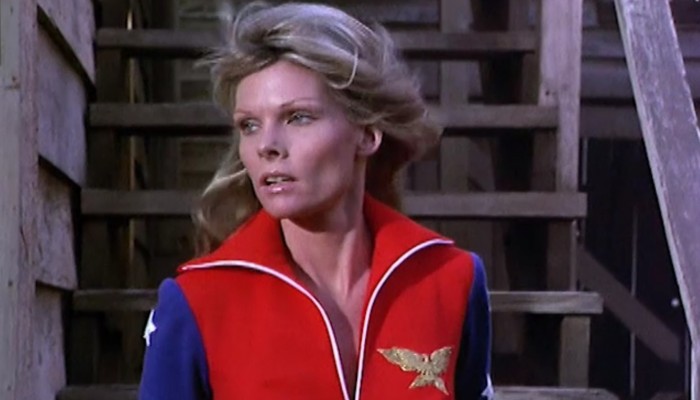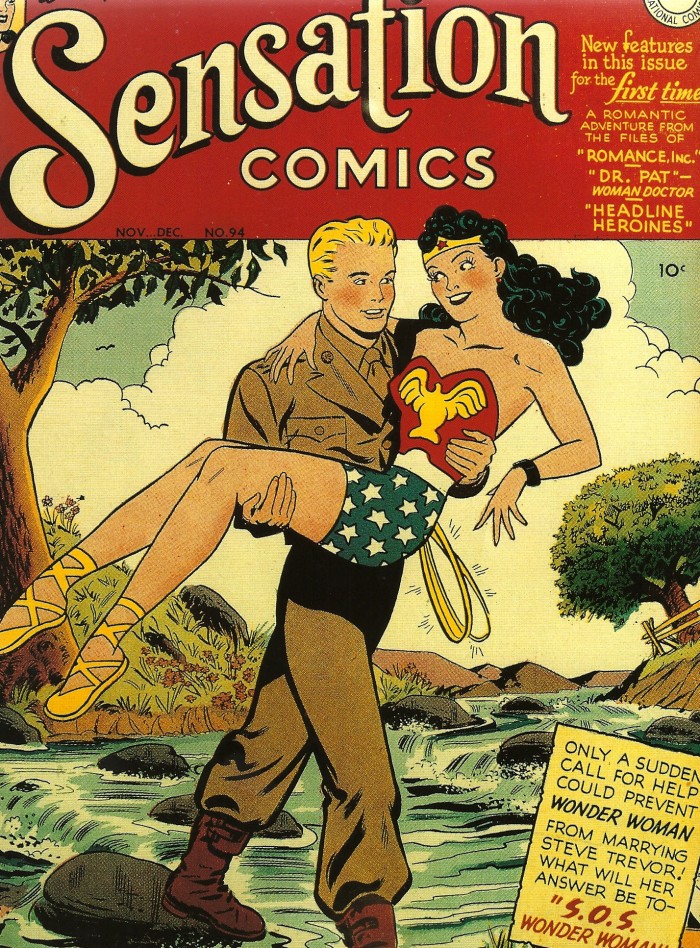A 1974 TV Movie Reveals What Makes Wonder Woman Great – By Getting Her Completely Wrong
For nearly 42 years, Lynda Carter was the only recognizable live-action Wonder Woman. Her image has endured as TV reboots have died in development and film adaptations have struggled to hold down screenwriters and stars. She's about to get some long overdue company from Gal Gadot, as the first ever Wonder Woman feature film debuts this weekend. But Carter was never actually alone. She was actually the second Wonder Woman to hit television screens, but her predecessor was far less successful.One year before Carter's Wonder Woman series debuted on ABC, the network tried an entirely different pilot for the comic book icon. It starred former tennis pro Cathy Lee Crosby as Wonder Woman, alias Diana Prince. Like Carter's iteration, Crosby's Wonder Woman sported a pair of gold bracelets and fought international crime. But she was missing a few key character details. She didn't wear a tiara or star-spangled shorts. She had blond hair instead of brown. Most crucially, she didn't have any actual powers. Just a really mean back kick.
ABC introduced this strange Wonder Woman to audiences through an extended pilot running just over an hour. It aired on a Tuesday night in March of 1974 as the network's "Movie of the Week." The ratings weren't bad, but the producers decided to scrap a potential series and go back to square one. This baffling, bizarre little TV movie was the only survivor of their initial concept, one that fundamentally misunderstood Wonder Woman's greatest qualities and true identity.
Setting the Scene
Wonder Woman begins with a ticking clock. In one simultaneous swoop, affiliates of the villainous Abner Smith (Ricardo Montalban) steal intel from secure locations in Paris, Berlin, London, Rio de Janerio, and Istanbul. The books they have could compromise U.S. agents – and Smith won't give them up unless Steve Trevor (Kaz Garas) and his government pals cough up $15 million in the next 48 hours. Trevor's secretary Diana Prince happens to hear this unfortunate news as he delivers it to a room full of his top men. She promptly leaves for a "dental appointment" and jets off to France, where she stops Smith and his right-hand man George Calvin (Andrew Prine) through a combination of karate, cunning, and donkey chases.Abner Smith may not sound like a sexy villain name, but "Mr. Smith," as his cronies call him, strains for every ridiculous bad guy trope in the book. His face is shrouded by the back of his chair. He wears immaculate all-white suits and smokes cigars incessantly. He has an actual cave lair complete with a getaway helicopter and bar cart full of fine liquors. All he needs is a "Monsieur Bond" to address and he'd be the silliest adversary Sean Connery ever faced.
Mr. Smith also employs a pair of assassins named Cass and Joe who sport identical leather jackets, identical corduroy pants, identical black shirts, and (most hilariously) identical haircuts. It's never explained if they're brother and sister, or just really like coordinating their outfits each morning.
As Mr. Smith and his leather twins might indicate, Wonder Woman is styled exactly like a typical 1970s spy series. The tacky leisure suits are plentiful and Artie Butler's theme song can only be described as funky. With these pieces in place, all Diana has to do is show up ready to sleuth. In go-go boots, of course.
A Scrubbed Superhero
There's one tiny problem with stripping a superhero of her powers: she's not a superhero anymore. Diana Prince is barely called Wonder Woman in this extended pilot and, in some insane way, that kinda makes sense. There's nothing particularly wondrous or awe-inspiring about Crosby's take on the heroine. She's just a level-headed lady who can throw a karate chop and follow a clue.But the show implies Diana's exceptionalism lies chiefly in that poise. Isn't it impressive how she stayed cool with that snake coiled around her leg? Could you believe her non-reaction when George propositioned her right at dinner? Wasn't it incredible how she followed a trail of gum wrappers (seriously) to the bad guys? Wonder Woman has always been a woman of remarkable composure, but that's not why she's inspired generations of little girls. She's a leader who fights for justice and compassion. She helps others without her own superhuman advantages, and can break free of any shackle any man places on her. Little of that translates in Crosby's performance, which skews more towards cool chick detective than warrior princess. But this is hardly her fault, considering the show's weird aversion to Wonder Woman's origin story.
Paradise Island or Bust
Wonder Woman seems at once totally uninterested in Diana's past and unable to escape it. Her home of Paradise Island, which is cued with overblown "heavenly" music and soft frame edges, is dispatched in less than three minutes. Queen Hippolyte has just enough time to spout a few maxims about the sensitivity of the Amazons before Diana is dropped into the mortal world, where she is quite literally surrounded by men. Her boss, Steve Trevor, worries about her missions like a concerned father. He and all her male colleagues call her "Dee"; one gives her surprise roses. Her major adversary Mr. Smith is so smitten with her that he declares "I love you, Wonder Woman" as he's being hauled away in handcuffs. George Calvin despises Diana with a murderous rage but he still tries to seduce her. The only non-Amazon woman with a role at all is Cass, the female half of the leather twins – but Diana squares off more frequently with Cass's male partner, Joey.But then there's the Amazons. Despite this series' itchiness to get off the island, it can't resist the allure of an Amazon gone bad. Diana is warned near the beginning of her mission that one of her sisters, Ahnjayla, has left Paradise Island and is not to be trusted. It's soon revealed that she's cast her lot with Mr. Smith, partly for the free jewelry and partly, it seems, to settle an old score with Diana. They apparently battled before, and Ahnjayla has never forgotten it. Ahnjayla still cannot win against Diana, but she teases a return – and promises not to spare Diana's life if she defeats her.The series clearly wanted to set Ahnjayla up as a recurring villain, but this good vs. evil Amazon dynamic comes off as awfully lazy, especially given that we barely know who these women are and what they can do. The show takes a similarly muddied approach to Diana's famous accessories. Her bracelets never stop a bullet, but she uses them to test electric fences. She has no golden lasso of truth, but rope does spool out of her lame utility belt. She makes a passing reference to her invisible plane, but it's hard to imagine this series ever seriously committing to showing it. Wonder Woman knows it needs a few of the superhero's touchstones to set itself apart from every other spy series on television, but it's deeply afraid of exploring anything that makes Wonder Woman who she is.
How Did This Even Happen?
Anyone watching this extended pilot in 2017 has to wonder how it even earned network approval. But at the time, this version of Wonder Woman wasn't so off-the-mark.The Wonder Woman comics had fallen into a weird rut after the creator, William Moulton Marston, died from skin cancer in 1947. First, Diana was retooled into a more submissive, doting damsel to Steve Trevor – the kind of dainty woman who needs to be carried over streams. This Wonder Woman better reflected the postwar era, when women were urged to step down from the jobs they'd taken during World War II and let returning soldiers have them instead. They'd done their duty, but now it was time to return to domesticity. Why should Wonder Woman be any exception?Even as restrictive gender norms eased slightly in the 1960s, Wonder Woman suffered from nonsensical new revisions. By 1968, she'd completely surrendered her powers to remain in the mortal world. She got a mod makeover, opened a clothing store, and basically did whatever her martial arts mentor I Ching told her to do. Maybe that explains the failed 1967 Who's Afraid of Diana Prince? pilot, which pitches Wonder Woman as a clumsy, delusional woman who "thinks she has the beauty of Aphrodite." Her mom chides her constantly about getting married The pilot was never aired or completed, but you can watch five miserable minutes of it on YouTube:
This utterly antithetical Wonder Woman was not well-received and a small army of second-wave feminists stepped in to save her. Gloria Steinem was a lifelong Wonder Woman fan. She read the comics with a flashlight under her covers as a girl, and ran the superhero on the cover of Ms. magazine in 1972. Steinem and the other editors at Ms. wanted to put together a book celebrating the original Wonder Woman, so they set an appointment with the men at National Periodical Publishers (the forerunner to DC Comics). According to the Los Angeles Times, the women of Ms. got much more than their blessing; they convinced the publishers to take Wonder Woman back to her roots.Since the comics had already changed Wonder Woman back to her old self by 1974, when this TV movie premiered, the Crosby series arrived somewhat dated on arrival. But ABC was only a year away from the second, more successful attempt at the superhero. Carter's famous series debuted on November 7, 1975. When Wonder Woman stepped into the frame this time, she was fearless, powerful, and keenly aware of her origins.
The Legacy of Diana Prince
Crosby's Wonder Woman has been largely forgotten, erased as a minor error on the way to a full-fledged Wonder Woman television series. But the failed experiment laid out an important lesson for future adaptations: misuse Wonder Woman at your own peril. She is not a stock lead character who can fit neatly into any genre show of the moment. She's a distinctive heroine who only works when she's allowed to be an unapologetic Amazonian princess – with bracelets that aren't just for show.
